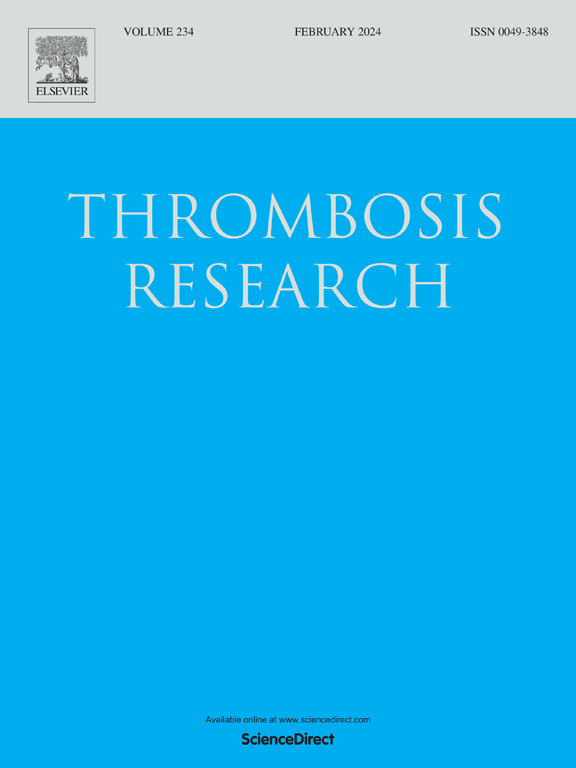CXCL13/CXCR5 axis facilitates TFH expansion and correlates with disease severity in adults with immune thrombocytopenia
IF 3.7
3区 医学
Q1 HEMATOLOGY
引用次数: 0
Abstract
Background
Immune thrombocytopenia (ITP) is an autoimmune bleeding disorder defined by a diminished platelet count. ITP pathogenesis involves intricate changes to both cellular and humoral immunity. The pivotal roles of follicular helper T (TFH) cells in the maturations of B cells and the production of antibodies are well-established. However, the specific role of TFH to the immunopathogenesis of ITP remain incompletely understood. This study aimed to clarify the association of CXCL13/CXCR5 axis with TFH in adults with ITP.
Methods
A total of 97 ITP patients and 41 healthy controls were enrolled. CD4+CXCR5+ TFH, CD4+CXCR5+PD-1+ TFH, CD4+CXCR5+Foxp3+ follicular regulatory T cells (TFR), and desialylated platelets in peripheral blood were measured by flow cytometry. Plasma cytokines were assessed by enzyme-linked immunosorbent assay. CD4+ T cells cocultured with chemokine CXCL13 in vitro was performed for the measurement of TFH proliferation. Intracellular production of reactive oxygen species (ROS) was examined by dichlorodihydrofluorescein diacetate (DCFH-DA) probe staining.
Results
We observed a significant increase in circulating TFH and a marked decrease in circulating TFR in the entire ITP cohort. The ratio of TFH/TFR was elevated, accompanied by heightened levels of platelet desialylation, cytokines BAFF, HMGB1, and IL-21, while levels of IL-10 were downregulated in adults with ITP. Notably, patients with ITP exhibiting platelet count below 50 × 109/L had dramatically elevated levels in both chemokine CXCL13 and its receptor CXCR5+ TFH compared to those with platelet count above 100 × 109/L. High frequencies of TFH correlated with poor therapeutic response. Furthermore, in vitro CD4+ T cell proliferation assay demonstrated a CXCL13 dose-dependent increase in the frequencies in both CD4+CXCR5+ TFH and CD4+CXCR5+PD-1+ TFH from ITP patients. Intriguingly, DCFH-DA assay illustrated a significant enhancement in intracellular ROS generation in CXCR5+ T cell subsets, especially in CD4+CXCR5+PD-1+ TFH from 4 patients with ITP.
Conclusions
These results underscore the pivotal role of CXCL13/CXCR5 axis-drived TFH expansion in the pathogenesis of ITP, providing a potential disease severity biomarker.
CXCL13/CXCR5轴促进TFH扩展,并与免疫性血小板减少症成人患者的疾病严重程度相关。
背景:免疫性血小板减少症(ITP免疫性血小板减少症(ITP)是一种以血小板数量减少为特征的自身免疫性出血性疾病。ITP的发病机制涉及细胞免疫和体液免疫的复杂变化。滤泡辅助 T 细胞(TFH)在 B 细胞成熟和抗体产生中的关键作用已得到公认。然而,人们对 TFH 在 ITP 免疫发病机制中的具体作用仍不甚了解。本研究旨在阐明成人 ITP 患者中 CXCL13/CXCR5 轴与 TFH 的关系:方法:共招募了97名ITP患者和41名健康对照者。流式细胞术测量了外周血中的 CD4+CXCR5+ TFH、CD4+CXCR5+PD-1+ TFH、CD4+CXCR5+Foxp3+ 滤泡调节性 T 细胞(TFR)和去淀粉血小板。血浆细胞因子通过酶联免疫吸附试验进行评估。在体外与趋化因子 CXCL13 共同培养 CD4+ T 细胞,以测量 TFH 的增殖情况。通过二氯二氢荧光素二乙酸酯(DCFH-DA)探针染色检测细胞内活性氧(ROS)的产生:结果:我们观察到,在整个 ITP 群体中,循环 TFH 明显增加,循环 TFR 明显减少。在成人 ITP 患者中,TFH/TFR 的比值升高,同时血小板脱ialylation、细胞因子 BAFF、HMGB1 和 IL-21 的水平升高,而 IL-10 的水平下降。值得注意的是,血小板计数低于 50 × 109/L 的 ITP 患者与血小板计数高于 100 × 109/L 的患者相比,趋化因子 CXCL13 及其受体 CXCR5+ TFH 的水平显著升高。TFH的高频率与不良治疗反应相关。此外,体外 CD4+ T 细胞增殖试验表明,ITP 患者 CD4+CXCR5+ TFH 和 CD4+CXCR5+PD-1+ TFH 的频率增加与 CXCL13 的剂量有关。耐人寻味的是,DCFH-DA 检测显示,CXCR5+ T 细胞亚群细胞内 ROS 的生成显著增加,尤其是来自 4 名 ITP 患者的 CD4+CXCR5+PD-1+ TFH:这些结果强调了 CXCL13/CXCR5 轴驱动的 TFH 扩增在 ITP 发病机制中的关键作用,提供了一种潜在的疾病严重程度生物标志物。
本文章由计算机程序翻译,如有差异,请以英文原文为准。
求助全文
约1分钟内获得全文
求助全文
来源期刊

Thrombosis research
医学-外周血管病
CiteScore
14.60
自引率
4.00%
发文量
364
审稿时长
31 days
期刊介绍:
Thrombosis Research is an international journal dedicated to the swift dissemination of new information on thrombosis, hemostasis, and vascular biology, aimed at advancing both science and clinical care. The journal publishes peer-reviewed original research, reviews, editorials, opinions, and critiques, covering both basic and clinical studies. Priority is given to research that promises novel approaches in the diagnosis, therapy, prognosis, and prevention of thrombotic and hemorrhagic diseases.
 求助内容:
求助内容: 应助结果提醒方式:
应助结果提醒方式:


